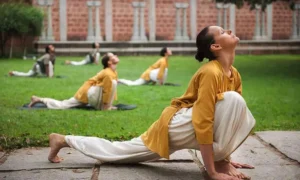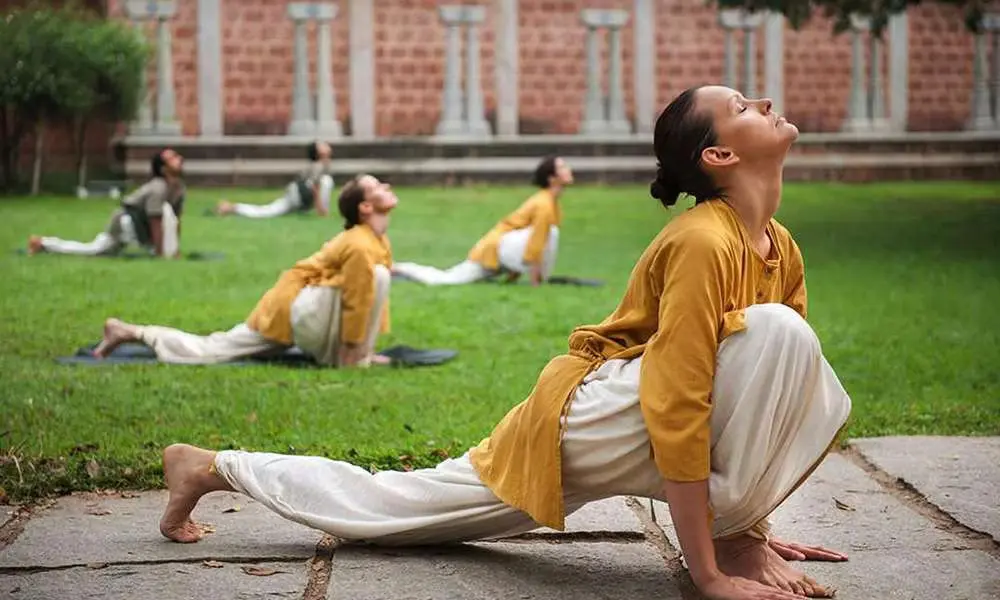Brahmancharya: Is it Just Not Having Physical Fun!
Have you ever heard the word “Brahmacharya” and wondered what it means? Well, forget everything you might think it means because today we’re going to explain it in a simple way!
Some people think Brahmacharya is all about not having Physical fun, but that’s not quite true. The real meaning is much deeper.
“Brahmacharya” It’s a Sanskrit term that means “the conduct of a Brahmachari,” and a Brahmachari is someone who practices self-control. But Brahmacharya is much more than just not having romantic relationships. It’s a way of life that can benefit everyone, from students to married couples.
What is Brahmacharya?
The Sanskrit Meaning of Brahmacharya:
Brahmacharya originates from two Sanskrit words: “Brahman,” signifying the ultimate reality or universal energy, and “charya,” meaning conduct or way of life. Therefore, Brahmacharya translates to living in a way that connects you to this fundamental energy.
In simpler words, Brahmacharya is about using your energy wisely. It’s about channeling your physical and mental energy towards achieving your goals, whether it’s excelling in studies, building a strong work ethic, or simply living a more mindful life.
It’s not about denying yourself all pleasures, but rather about using your energy wisely. Imagine a phone with an incredibly powerful battery. Brahmacharya is like using that power for positive purposes, not wasting it on trivial matters.
Here’s a clearer understanding of what Brahmacharya entails:
Managing your emotions: Not allowing anger, jealousy, or the fear of missing out to control your actions.
Cultivating positive thoughts: Maintaining a positive and clear mind.
Diligence and honesty: Applying positive energy to all your endeavors.
Self-discipline: Knowing when to decline things that might not be beneficial for you.
Spiritual growth: Connecting with a deeper energy source that fosters happiness and connection.
The Four Stages of Life according to Ashram Upnishad
These 4 stages of life are called the ashrams or stages of life. Brahmacharya represents the first stage of life. Means the learner of life. Basically it mentions the students life. Away from all desires of world. only desire to achive the knowledge. The knowledge of self, knowledge of Braham. Here are the 4 stages mentioned:
Brahmacharya (Student Life)
Grihastha (Householder Life)
Vanaprastha (Forest Dwelling)
Sannyasa (Renunciation)
Bharamcharya is Beyond Lust and Physicality
In direct connection between Brahmacharya and Brahman, the supreme universal energy. Now, let’s go deeper into understanding Brahman and how it relates to your life.
Brahman is often thought of as everything that exists beyond the confines of our daily experiences. It’s limitless, infinite, and transcends form, shape, or physical presence. While our minds often grapple with limited concepts, Brahman is boundless. It’s without color, shape, or a physical body. Yet, it exists. It’s also referred to as the true Self, the Atman. Brahman is beyond definition or explanation, for we can only analyze and understand things within world we can see and experience
Now, the question arises: how can we live in harmony with something that cannot be seen or perceived? After all, Brahmacharya implies living in Brahman. To understand this, we must understand that an individual who lives their life aligned with the true Self, the Atman, can be considered a Brahmachari, one who lives in Brahman.
Living in harmony with the Atman is no easy feat. Imagine the effort required to shed our egoistic tendencies, greed, and selfishness. However, for those who succeed in this endeavor and live an Atma-centered, truth-aligned life, happiness and sorrow become distant concepts.
Who is a Brahmachari?
Brahmacharya is not merely about suppressing physical desires or abstaining from bodily pleasures. Its true essence lies in the direct connection with Brahman. A Brahmachari is someone who has transcended their ego to the point where they no longer harbor personal desires. They eat, sleep, and act solely in accordance with Brahman’s will. For a true Brahmachari, worldly possessions and desires hold little value. They live in Brahman, unaffected by external factors such as insults, wealth, status, etc.
Similarly, lust becomes an insignificant matter for a Brahmachari. They neither gaze upon women or men with the intention of fulfilling their desires nor do they avoid them altogether. Instead, they can interact with any individual, male or female, maintaining a healthy and pure relationship. Freedom from desires forms a small part of Brahmacharya.
Myths and Misconceptions about Brahmacharya
Due to our association of Brahmacharya with the suppression of physical desires, several misconceptions have arisen:
Brahmachari individuals should not marry:
We often perceive Brahmacharya as practiced by those who are not sexually attracted or interested in romantic relationships. However, a Brahmachari is someone who has transcended their ego, not their capacity for love and companionship.
Brahmachari individuals should not be attracted to the opposite sex:
We assume that Brahmachari individuals should be devoid of any attraction towards the opposite sex. However, a Brahmachari’s goal is not to suppress natural feelings but to live in harmony with them without being controlled by them.
Brahmachari individuals should observe strict dietary restrictions and perform rituals:
While certain practices like fasting and devotional singing can aid in self-discipline, they are not the sole defining factors of Brahmacharya. The true essence of Brahmacharya lies in aligning one’s life with the true Self, Brahman.
Brahmacharya is about preserving semen:
When an individual’s sole focus becomes semen retention, their ability to engage in noble actions diminishes. Brahmacharya is not about suppressing bodily functions but about using them in a way that aligns with one’s spiritual growth.
What are the Benefits of Brahmacharya
Key aspects of Brahmacharya include:
Paramatma Chintan: Contemplating on the divine, fostering a constant connection with the supreme energy.
Atmarama: Finding contentment within oneself, independent of external circumstances or desires.
Sattvik Jeevan:
Embracing a pure and virtuous lifestyle, characterized by noble thoughts, actions, and speech.
Viryarakshan: Preserving one’s vital energy (virya) not out of fear or suppression, but out of a conscious choice to utilize it for higher purposes.
Bhakti: Engaging in devotional practices, cultivating love and devotion towards the divine.
Vidya Grahan: Pursuing knowledge and wisdom, expanding one’s understanding of the world and oneself.
When we follow up the Brahmachari path we have
- Improved focus and concentration: When you’re not constantly distracted by your urges, you can focus better on your studies, work, or any other activity you set your mind to.
(Remember urges are not just physical desires.)
- Increased energy and vitality: Brahmacharya helps conserve your vital energy, which can lead to increased stamina and a more positive outlook on life.
- Stronger willpower and self-discipline: Sticking to Brahmacharya requires discipline, and this discipline can spill over into other areas of your life.
- Improved mental clarity: By controlling your senses and desires, you can achieve a calmer and more peaceful mind.
Why is Brahmacharya Needed in Today's World?
In today’s fast-paced world, we’re constantly bombarded with messages that can be stimulating and distracting. Brahmacharya offers a way to step back from that and focus on what truly matters to us. It’s not about denying yourself pleasure, but about enjoying it in a balanced and responsible way.
How to Start Your Brahmacharya Journey
Inner Intention: What is The Foundation of Brahmacharya
Brahmacharya is not merely about following external rules or restrictions; it’s a profound inner transformation that stems from a deep yearning for spiritual growth and connection with the divine. It’s a conscious choice to align one’s thoughts, actions, and desires with the ultimate truth, transcending the limitations of the ego and worldly temptations.
Seeking Divine Strength
Recognizing one’s own limitations and seeking divine strength is crucial in adhering to Brahmacharya. With humility and devotion, one should approach the divine, seeking the power and grace to navigate the challenges and temptations that may arise on this path.
Understanding the Mind's Nature
The mind is a powerful tool, capable of both immense creativity and destructive impulses. Instead of constantly trying to control the mind, a wiser approach is to understand its nature and identify the triggers that lead it towards undesirable thoughts and behaviors.
Breaking the Links
Once the triggers are identified, it’s essential to take swift and decisive action to break the links that connect them to negative patterns. This could involve avoiding certain environments, distancing oneself from unhealthy influences, or engaging in activities that cultivate positive thoughts and emotions.
Here are 8 simple rules to get you started with Brahmacharya:
- Mind your diet: Eat simple, wholesome foods and avoid stimulants like caffeine and excess sugar.
- Get enough sleep: Being well-rested helps you resist temptations and maintain self-control.
- Exercise regularly: Physical activity helps channel your energy and keeps your mind clear.
- Practice moderation: Don’t overindulge in anything, from food to entertainment.
- Cultivate positive relationships: Surround yourself with people who support your goals and uplift you.
- Engage in activities that inspire you: Find hobbies or creative pursuits that bring you joy and fulfillment.
- Practice mindfulness: Meditation and breathing exercises can help you become more aware of your thoughts and emotions.
- Seek guidance: If you’re serious about Brahmacharya, consider talking to a spiritual teacher or mentor who can offer support and advice.
Things to Remember during Brahmacharya or Celibacy
Remember, Brahmacharya is not a race or a competition; it’s a lifelong journey of self-discovery, self-mastery, and conscious living.
- Brahmacharya is a gradual process. Don’t be discouraged if you slip up sometimes. Just pick yourself up and keep going.
- It’s not about punishment, but about self-improvement.
- Brahmacharya can be practiced by anyone, regardless of their age, marital status, or religious beliefs.
Who are the Great Brahmachari in 20th Century
Throughout history, many inspiring individuals have embraced the principles of Brahmacharya. Some examples include:
- Swami Vivekananda, a renowned Hindu monk, is known for his teachings on self-discipline and spiritual realization.
- Mahatma Gandhi, the leader of India’s independence movement, practiced Brahmacharya as a way to conserve his energy for the cause of freedom.
These are just a few examples. There are countless others who have found strength and purpose through the practice of Brahmacharya.
Further Exploration about Brahamcharya
If you’d like to learn more about Brahmacharya, here are a few resources to get you started:
- Book: “The Benefits of Brahmacharya: A Collection of Writings About the Spiritual, Mental, and Physical Benefits of Continence”
Remember, Brahmacharya is a journey, not a destination. It’s about continuously striving for self-improvement and living a life filled with purpose and inner peace.
Frequently Asked Questions about Brahamcharya
What should i eat During Brahamcharya?
Non Spicy, Simple Vegetarian Food.
When to wake up in Brahamcharya?
Sleep is necessary, Try to wake up before Sunrise if you are not into your night shifts. However 6-7 hours sleep is enough. Body adopt habbits in 3 weeks.
How long should i follow Brahamcharya?
Give it 45 days first. Then Extend to 90 days for better Benefits.
Who is Greatest Brahmachari of all time?
In India (Bharat) Lord Hanuman is the greatest brahamchari of all time. Most of Brahamcharya Followers get inspiration from him. He is the God of power, strength, agility.
What is Yoga ? What is the Defination of Yoga
What is Yoga ? We will discuss the defination of...
Read MoreWhy Yoga Teacher Training in Rishikesh?
Rishikesh, India - the perfect place to become a yoga...
Read MoreWhat is Asana & what is Yoga Asana ?
Do you know what is asana and what is yoga...
Read MoreHatha Yoga Teacher Training – A Guide to India’s Most Ancient Yoga
There are numerous types of yoga performed all over the...
Read More









